The Volcanic-Rich Layer of the “Camporotondo (Marche, Italy)” Section: Petrography and Sedimentation of an Unknown Distal Messinian Eruption
Abstract
:1. Introduction
2. Geological Setting and Sampling
3. Analytical Methods
4. Results
4.1. Field and Mesoscopic Stratigraphy
4.2. Microscopic Features
4.3. XRPD
4.4. Whole and Micro-Chemical Compositions
5. Discussion
Supplementary Materials
Author Contributions
Funding
Data Availability Statement
Acknowledgments
Conflicts of Interest
References
- Alloway, B.; Lowe, D.; Larsen, G.; Shane, P.; Westgate, J.A. Tephrochronology. The Encyclopaedia of Quaternary Science, 2nd ed.; Elsevier: Amsterdam, The Netherlands, 2013; Volume 4, pp. 277–304. [Google Scholar]
- Giuliani, L.; Iezzi, G.; Mollo, S. Dynamics of volcanic systems: Physical and chemical models applied to equilibrium versus disequilibrium solidification of magmas. AGU Books 2020, 16, 373–418. [Google Scholar]
- Manga, M.; Patel, A.; Dufek, J. Rounding of pumice clasts during transport: Field measurements and laboratory studies. Bull. Volcanol. 2011, 73, 321–333. [Google Scholar] [CrossRef] [Green Version]
- Bonadonna, C.; Costa, A. Estimating the volume of tephra deposits: A new simple strategy. Geology 2012, 40, 415–418. [Google Scholar] [CrossRef]
- Houghton, B.; Carey, R.J. Chapter 34—Pyroclastic Fall Deposits. In The Encyclopedia of Volcanoes, 2nd ed.; Sigurdsson, H., Ed.; Academic Press: Cambridge, MA, USA, 2015; pp. 599–616. [Google Scholar] [CrossRef]
- Buchwaldt, R. Pyroclastic Flow. In Encyclopedia of Natural Hazards; Encyclopedia of Earth Sciences, Series; Bobrowsky, P.T., Ed.; Springer: Dordrecht, The Netherlands, 2013. [Google Scholar] [CrossRef]
- Cas, R. Mass-Flow Arenites from a Paleozoic Interarc Basin, New South Wales, Australia: Mode and Environment of Emplacement. J. Sediment. Res. 1979, 49, 29–44. [Google Scholar] [CrossRef]
- Cioni, R.; Pistolesi, M.; Rosi, M. Chapter 29—Plinian and Subplinian Eruptions. In The Encyclopedia of Volcanoes, 2nd ed.; Sigurdsson, H., Ed.; Academic Press: Cambridge, MA, USA, 2015; pp. 519–535. [Google Scholar] [CrossRef] [Green Version]
- Lowe, D.J.; Pearce, N.J.C.; Jorgensen, M.A.; Kuehn, S.C.; Tryon, C.A.; Hayward, C.L. Correlating tephras and cryptotephras using glass compositional analyses and numerical and statistical methods: Review and evaluation. Quat. Sci. Rev. 2017, 175, 1–44. [Google Scholar] [CrossRef]
- Wohletz, K.H.; Krinsley, D. Scanning Electron Microscopy of Basaltic Hydromagmatic Ash; Los Alamos National Laboratory Report LA-UR, 82–1433; University of California, Los Alamosa National Laboratory: Los alamos, NM, USA, 1982; 43p. [Google Scholar]
- Cole, J.W. Tephra. In Petrology. Encyclopedia of Earth Science; Springer: Boston, MA, USA, 1989. [Google Scholar] [CrossRef]
- Thorarinsson, S. The eruption of Mt. Hekla 1947–1948. Bull. Volcanol. 1950, 10, 157–168. [Google Scholar] [CrossRef]
- Cas, R.; Wright, J. Volcanic Succession Modern and Ancient; Springer: Dordrecht, The Netherlands, 1988. [Google Scholar] [CrossRef]
- Fisher, R.V.; Schmincke, H.U. Pyroclastic Rocks; Springer: Berlin/Heidelberg, Germany, 1984. [Google Scholar] [CrossRef]
- Iverson, N.A.; Kalteyer, D.; Dunbar, N.W.; Kurbatov, A.; Yates, M. Advancements and best practices for analysis and correlation of tephra and cryptotephra in ice. Quat. Geochronol. 2017, 40, 45–55. [Google Scholar] [CrossRef]
- Loughlin, S.C. Volcanoes and Volcanic Eruptions. In Encyclopedia of Natural Hazards; Bobrowsky, P.T., Ed.; Encyclopedia of Earth Sciences Series; Springer: Dordrecht, The Netherlands, 2013. [Google Scholar] [CrossRef]
- Monteath, A.J.; Hughes, P.D.M.; Wastegård, S. Evidence for distal transport of reworked Andean tephra: Extending the cryptotephra framework from the Austral volcanic zone. Quat. Geochronol. 2019, 51, 64–71. [Google Scholar] [CrossRef] [Green Version]
- Ponomareva, V.; Portnyagin, M.; Davies, S.M. Tephra without Borders: Far-Reaching Clues into Past Explosive Eruptions. Front. Earth Sci. 2015, 3, 83–99. [Google Scholar] [CrossRef] [Green Version]
- Schmincke, H.U. Volcanic Edifices and Volcanic Deposits. In Volcanism; Schmincke, H.U., Ed.; Springer: Berlin/Heidelberg, Germany, 2004; pp. 127–154. [Google Scholar] [CrossRef]
- Freundt, A.; Schindlbeck-Belo, J.C.; Kutterolf, S.; Hopkins, J.L. Tephra layers in the marine environment: A review of properties and emplacement processes. Geol. Soc. London, Spéc. Publ. 2021, 520. [Google Scholar] [CrossRef]
- Friedman, I.; Long, W. Volcanic glasses, their origins and alteration processes. J. Non-Cryst. Solids 1984, 67, 127–133. [Google Scholar] [CrossRef]
- Branney, M.J.; Kokelaar, P. Pyroclastic Density Currents and the Sedimentation of Ignimbrites. Geol. Soc. London Memoir 2002, 27, 152. [Google Scholar]
- Brown, R.J.; Andrews, G.D.M. Chapter 36—Deposits of Pyroclastic Density Currents. In The Encyclopedia of Volcanoes, 2nd ed.; Sigurdsson, H., Ed.; Academic Press: Cambridge, MA, USA, 2015; pp. 631–648. [Google Scholar] [CrossRef]
- Lowe, D.J. Tephrochronology and its application: A review. Quat. Geochronol. 2011, 6, 107–153. [Google Scholar] [CrossRef] [Green Version]
- Schneider, J.-L.; Le Ruyet, A.; Chanier, F.; Buret, C.; Ferrière, J.; Proust, J.-N.; Rosseel, J.-B. Primary or secondary distal volcaniclastic turbidites: How to make the distinction? An example from the Miocene of New Zealand (Mahia Peninsula, North Island). Sediment. Geol. 2001, 145, 1–22. [Google Scholar] [CrossRef]
- Talling, P.J.; Masson, D.G.; Sumner, E.J.; Malgesini, G. Subaqueous sediment density flows: Depositional processes and deposit types. Sedimentology 2012, 59, 1937–2003. [Google Scholar] [CrossRef]
- Kataoka, K.S.; Urabe, A.; Nagahashi, Y. Millennial-scale reworking of tephra in alluvial to shallow marine settings: Distinguishing pseudo-isochrons from genuine ones. Quat. Int. 2016, 397, 173–193. [Google Scholar] [CrossRef]
- Gudmundsdóttir, E.R.; Eiríksson, J.; Larsen, G. Identification and definition of primary and reworked tephra in Late Glacial and Holocene marine shelf sediments off North Iceland. J. Quat. Sci. 2011, 26, 589–602. [Google Scholar] [CrossRef]
- Manville, V.; Hodgson, K.A.; Houghton, B.F.; Keys, J.R.; White, J.D.L. Tephra, snow and water: Complex sedimentary responses at an active snow-capped stratovolcano, Ruapehu, New Zealand. Bull. Volcanol. 2000, 62, 278–293. [Google Scholar] [CrossRef]
- Rausch, J.; Grobéty, B.; Vonlanthen, P. Eifel maars: Quantitative shape characterization of juvenile ash particles (Eifel Volcanic Field, Germany). J. Volcanol. Geotherm. Res. 2015, 291, 86–100. [Google Scholar] [CrossRef] [Green Version]
- Stalder, N.F.; Fellin, M.G.; Caracciolo, L.; Guillong, M.; Winkler, W.; Milli, S.; Moscatelli, M.; Critelli, S. Dispersal pathways in the early Messinian Adriatic foreland and provenance of the Laga Formation (Central Apennines, Italy). Sediment. Geol. 2018, 375, 289–308. [Google Scholar] [CrossRef]
- Giuliani, L.; Iezzi, G.; Vetere, F.; Behrens, H.; Mollo, S.; Cauti, F.; Ventura, G.; Scarlato, P. Evolution of textures, crystal size distributions and growth rates of plagioclase, clinopyroxene and spinel crystallized at variable cooling rates from a mid-ocean ridge basaltic melt. Earth-Sci. Rev. 2020, 204, 103165. [Google Scholar] [CrossRef]
- Takashimizu, Y.; Iiyoshi, M. New parameter of roundness R: Circularity corrected by aspect ratio. Prog. Earth Planet Sci. 2016, 3, 2. [Google Scholar] [CrossRef] [Green Version]
- Sohn, C.; Sohn, Y.K. Distinguishing between primary and secondary volcaniclastic deposits. Sci. Rep. 2019, 9, 12425. [Google Scholar] [CrossRef] [PubMed] [Green Version]
- Satow, C.; Grant, K.M.; Wulf, S.; Schulz, H.; Mallon, A.; Matthews, I.; Lowe, J. Detection and Characterisation of Eemian Marine Tephra Layers within the Sapropel S5 Sediments of the Aegean and Levantine Seas. Quaternary 2020, 3, 6. [Google Scholar] [CrossRef] [Green Version]
- Pollard, A.M.; Blockley, S.P.E.; Ward, K.R. Chemical alteration of tephra in the depositional environment: Theoretical stability modelling. J. Quat. Sci. 2003, 18, 385–394. [Google Scholar] [CrossRef]
- Blong, R.; Enright, N.; Grasso, P. Preservation of thin tephra. J. Appl. Volcanol. 2017, 6, 10. [Google Scholar] [CrossRef] [Green Version]
- Gudmundsdóttir, E.R.; Eiríksson, J.; Larsen, G. Holocene marine tephrochronology on the Iceland shelf: An overview. Jökull 2012, 62, 53–72. [Google Scholar]
- Buckland, H.M.; Cashman, K.V.; Engwell, S.L.; Rust, A.C. Sources of uncertainty in the Mazama isopachs and the implications for interpreting distal tephra deposits from large magnitude eruptions. Bull. Volcanol. 2020, 82, 23. [Google Scholar] [CrossRef] [Green Version]
- Mahony, S.H.; Sparks, R.S.J.; Barnard, N.H. Quantifying uncertainties in marine volcanic ash layer records from ocean drilling cores. Mar. Geol. 2014, 357, 218–224. [Google Scholar] [CrossRef]
- Boygle, J. Variability of tephra in lake and catchment sediments, Svínavatn, Iceland. Glob. Planet. Chang. 1999, 21, 129–149. [Google Scholar] [CrossRef]
- D’Atri, A.; Pierre, F.D.; Lanza, R.; Ruffini, R. Distinguishing primary and resedimented vitric volcaniclastic layers in the Burdigalian carbonate shelf deposits in Monferrato (NW Italy). Sediment. Geol. 1999, 129, 143–163. [Google Scholar] [CrossRef]
- Griggs, A.J.; Davies, S.M.; Abbott, P.M.; Coleman, M.; Palmer, A.P.; Rasmussen, T.L.; Johnston, R. Visualizing tephra deposits and sedimentary processes in the marine environment: The potential of X-ray microtomography. Geochem. Geophys. Geosyst. 2015, 16, 4329–4343. [Google Scholar] [CrossRef] [PubMed] [Green Version]
- Carey, S.N.; Schneider, J.L. Chapter 7—Volcaniclastic Processes and Deposits in the Deep-Sea. Dev. Sedimentol. 2011, 63, 457–515. [Google Scholar] [CrossRef]
- Fisher, R.V. Rocks composed of volcanic fragments and their classification. Earth-Sci. Rev. 1966, 1, 287–298. [Google Scholar] [CrossRef]
- Cremonini, G.; Farabegoli, E. Note ill.ve alla Carta Geologica dell’Appennino Emiliano-Romagnolo; Università di Bologna: Bologna, Italy, 1982. [Google Scholar]
- Trua, T.; Manzi, V.; Roveri, M.; Artoni, A. The Messinian volcaniclastic layers of the Northern Apennines: Evidence for the initial phases of the Southern Tyrrhenian spreading? Ital. J. Geosci. 2010, 129, 269–279. [Google Scholar] [CrossRef]
- Aldinucci, M.; Bigazzi, G.; Dall’Antonia, B.; Da Prato, S.; Donia, F.; D’Orazio, M.; Foresi, L.M.; Mazzei, R.; Riforgiato, F.; Sandrelli, F.; et al. The upper Messinian post-evaporitic succession of Serredi Quarry (southern Tuscany, Italy): New stratigraphic data and geochronology of an ash layer. GeoActa 2005, 4, 67–82. [Google Scholar]
- Bassetti, M.; Lucchi, F.; Roveri, M. Physical stratigraphy of the Messinian post-evaporitic deposits in Central-southern Marche area (Appennines, Central Italy). Mem. Della Soc. Geol. Ital. 1994, 48, 275–288. [Google Scholar]
- Cantalamessa, G.; Centamore, E.; Chiocchini, U.; Micarelli, A.; Potetti, M. Il Miocene delle Marche. In La Geologia delle Marche. Studi Geologici Camerti; Centamore, E., Deiana, G., Eds.; Congresso Società Geologica Italiana: Roma, Italy, 1986; Volume Sp. 73°. [Google Scholar]
- Carloni, C.; Cati, F.; Borsetti, A.M.; Francavilla, F.; Mezzetti, R.; Savelli, C. Il limite Miocene-Pliocene nelle Marche centro-meridionali. Boll. Soc. Geol. Ital. 1974, 93, 823–836. [Google Scholar]
- Centamore, E.; Cantalamessa, G.; Micarelli, A.; Potetti, M.; Berti, D.; Bigi, S.; Morelli, C.; Ridolfi, M. Stratigrafia ed analisi di facies dei depositi del Miocene e del Pliocene inferiore dell’avanfossa Marchigiano-Abruzzese e delle zone limitrofe. Studi Geol. Camerti Spec. 1991, 1, 125–131. [Google Scholar]
- Guerrera, F.; Tonelli, G.; Veneri, F. Caratteri lito-sedimentologici e mineralogico-petrografici di vulcanoclastiti mioceniche presenti nella successione umbro-machigiana. Boll. Soc. Geol. Ital. 1986, 105, 307–325. [Google Scholar]
- Odin, G.S.; Ricci Lucchi, F.; Tateo, F.; Cosca, M.; Hunziker, J.C. Integrated stratigraphy of the Maccarone Section, Late Messinian (Marche Region, Italy). Developments in Palaeontology and Stratigraphy; Elsevier: Amsterdam, The Netherlands, 1995; pp. 531–545. [Google Scholar] [CrossRef]
- Savelli, D.; Wezel, F.C. Schema geologico del Messiniano del pesarese. Boll. Della Soc. Geol. Ital. 1979, 97, 165–188. [Google Scholar]
- Selli, R. Il Bacino del Metauro—Descrizione Geologica, Risorse Minerarie, Idrogeologia. Ed. Cassa di Risparmio di Fano, Fano. 1954. Available online: http://www.fondazionecarifano.it/libroselli/miocene2.html (accessed on 30 November 2020).
- Velev, S.; Stanimirova, T.; Dochev, D.; Bonev, K. X-ray diffraction analysis of tephra layers from Perunika Glacier, Livingston Island, Antarctica. Rev. Bulg. Geol. Soc. 2018, 79, 65–66. [Google Scholar]
- Roveri, M.; Manzi, V.; Bassetti, M.; Merini, M.; Ricci, F. Stratigraphy of the Messinian post-evaporitic stage in eastern-Romagna (northern Apennines, Italy). G. Geol. 1998, 60, 119–142. [Google Scholar]
- Roveri, M.; Lugli, S.; Manzi, V.; Schreiber, B. The Messinian salinity crisis: A sequence-stratigraphic approach. GeoActa Spec. Publ. 2008, 1, 117–138. [Google Scholar]
- Ricci Lucchi, F. The Oligocene to Recent Foreland Basins of the Northern Apennines; Foreland basins: Blackwell, Oxford, 1986; Volume 8, pp. 105–139. [Google Scholar]
- Bigi, S.; Casero, P.; Corrado, S.; Milli, S.; Moscatelli, M.; Stanzione, O. Geometric framework and thermal history of the Laga basin: Constraints for integrated basin analysis. Geophys. Res. Abstr. 2006, 8, 08484. [Google Scholar]
- Bigi, S.; Milli, S.; Corrado, S.; Casero, P.; Aldega, L.; Botti, F.; Moscatelli, M.; Stanzione, O.; Falcini, F.; Marini, M.; et al. Stratigraphy, structural setting and burial history of the Messinian Laga basin in the context of Apennine foreland basin system. J. Mediterr. Earth Sci. 2009, 1, 61–84. [Google Scholar] [CrossRef]
- Milli, S.; Moscatelli, M.; Stanzione, O.; Falcini, F. Sedimentology and physical stratigraphy of the Messinian turbidite deposits of the Laga Basin (central Apennines, Italy). Boll. Della Soc. Geol. Ital. 2007, 126, 255–281. [Google Scholar]
- Scisciani, V.; Montefalcone, R. Coexistence of thin- and thick-skinned tectonics: An example from the Central Apennines, Italy. Geol. Soc. Am. Spec. Pap. 2006, 114, 33–53. [Google Scholar]
- Cantalamessa, G.; Centamore, E.; Chiocchini, U.; Micarelli, A.; Potetti, M. Tectonic-sedimentary evolution of the northwestern part of the Laga Basin (upper Miocene-lower Pliocene, central-southern Marche). Mem. Della Soc. Geol. Ital. 1982, 24, 221–232. [Google Scholar]
- Bigi, S.; Calamita, F.; Cello, G.; Centamore, E.; Deiana, G.; Paltrinieri, W.; Pierantoni, P.P.; Ridolfi, M. Tectonics and sedimentation within a messinian foredeep in the central apennines, Italy. J. Pet. Geol. 1999, 22, 5–18. [Google Scholar] [CrossRef]
- Artoni, A. Messinian events within the tectono-stratigraphic evolution of the Southern Laga Basin (Central Apennines, Italy). Boll. Soc. Geol. Ital. 2004, 122, 447–465. [Google Scholar]
- Roveri, M.; Manzi, V. The Messinian salinity crisis: Looking for a new paradigm? Palaeogeogr. Palaeoclim. Palaeoecol. 2006, 238, 386–398. [Google Scholar] [CrossRef]
- Merico, A.; Iezzi, G.; Pace, B.; Ferranti, L.; Cremona, M.; Scafa, M.; Cavallo, A.; Colella, A.; Nazzari, M.; Scarlato, P. Grain size and grain size distribution of a lithified fault core in carbonates rocks using multi-scale image analysis: The example of the San Benedetto-Gioia dei Marsi fault (Central Italy). J. Struct. Geol. 2020, 134, 104017. [Google Scholar] [CrossRef]
- Prause, S.; Weisenberger, T.B.; Cappelletti, P.; Grimaldi, C.; Rispoli, C.; Jónasson, K.; Jackson, M.D.; Gudmundsson, M.T. Alteration progress within the Surtsey hydrothermal system, SW Iceland—A time-lapse petrographic study of cores drilled in 1979 and 2017. J. Volcanol. Geotherm. Res. 2020, 392, 106754. [Google Scholar] [CrossRef]
- Iezzi, G.; Mollo, S.; Ventura, G. Solidification behavior of natural silicate melts and volcanological implications. In Volcanoes: Formation, Eruptions and Modeling; Lewis, N., Moretti, A., Eds.; Nova Publishers: New York, NY, USA, 2009; pp. 127–151. [Google Scholar]
- Iezzi, G.; Della Ventura, G.; Tribaudino, M.; Nemeth, P.; Margiolaki, I.; Cavallo, A.; Gaillard, F.; Behrens, H. Phase transition induced by solid solution: The BCa-BMg substitution in richteritic amphiboles. Am. Miner. 2010, 95, 369–381. [Google Scholar] [CrossRef]
- Iezzi, G.; Caso, C.; Ventura, G.; Vallefuoco, M.; Cavallo, A.; Behrens, H.; Mollo, S.; Paltrinieri, D.; Signanini, P.; Vetere, F. First documented deep submarine explosive eruptions at the Marsili Seamount (Tyrrhenian Sea, Italy): A case of historical volcanism in the Mediterranean Sea. Gondwana Res. 2014, 25, 764–774. [Google Scholar] [CrossRef]
- Iezzi, G.; Lanzafame, G.; Mancini, L.; Behrens, H.; Tamburrino, S.; Vallefuoco, M.; Passaro, S.; Signanini, P.; Ventura, G. Deep sea explosive eruptions may be not so different from subaerial eruptions. Sci. Rep. 2020, 10, 6709. [Google Scholar] [CrossRef] [Green Version]
- Lanzafame, G.; Iezzi, G.; Mancini, L.; Lezzi, F.; Mollo, S.; Ferlito, C. Solidification and Turbulence (Non-laminar) during Magma Ascent: Insights from 2D and 3D Analyses of Bubbles and Minerals in an Etnean Dyke. J. Pet. 2017, 58, 1511–1533. [Google Scholar] [CrossRef]
- Vetere, F.; Iezzi, G.; Behrens, H.; Holtz, F.; Ventura, G.; Misiti, V.; Cavallo, A.; Mollo, S.; Dietrich, M. Glass forming ability and crystallisation behaviour of sub-alkaline silicate melts. Earth-Sci. Rev. 2015, 150, 25–44. [Google Scholar] [CrossRef]
- White, J.D.L.; Houghton, B.F. Primary volcaniclastic rocks. Geology 2006, 34, 677–680. [Google Scholar] [CrossRef]
- Lanzafame, G.; Mollo, S.; Iezzi, G.; Ferlito, C.; Ventura, G. Unraveling the solidification path of a pahoehoe “cicirara” lava from Mount Etna volcano. Bull. Volcanol. 2013, 75, 703. [Google Scholar] [CrossRef]
- Liu, E.J.; Cashman, K.V.; Rust, A.C. Optimising shape analysis to quantify volcanic ash morphology. GeoResJ 2015, 8, 14–30. [Google Scholar] [CrossRef] [Green Version]
- Baiyegunhi, C.; Liu, K.; Gwavava, O. Grain size statistics and depositional pattern of the Ecca Group sandstones, Karoo Supergroup in the Eastern Cape Province, South Africa. Open Geosci. 2017, 9, 554–576. [Google Scholar] [CrossRef]
- Shoji, D.; Noguchi, R.; Otsuki, S.; Hino, H. Classification of volcanic ash particles using a convolutional neural network and probability. Sci. Rep. 2018, 8, 8111. [Google Scholar] [CrossRef]
- Wohletz, K.H. Mechanisms of hydrovolcanic pyroclast formation: Grain-size, scanning electron microscopy, and experimental studies. J. Volcanol. Geotherm. Res. 1983, 17, 31–63. [Google Scholar] [CrossRef]
- Andrews, J.T.; Kristjansdottir, G.B.; Eberl, D.D.; Jennings, A.E. A quantitative x-ray diffraction inventory of volcaniclastic inputs into the marine sediment archives off Iceland: A contribution to the Volcanoes in the Arctic System programme. Polar Res. 2013, 32. [Google Scholar] [CrossRef] [Green Version]
- Cersoy, S.; Martinetto, P.; Bordet, P.; Hodeau, J.L.; Van Elslande, E.; Walter, P. Identifying and quantifying amorphous and crystalline content in complex powdered samples: Application to archaeological carbon blacks. J. Appl. Crystallogr. 2016, 49, 585–593. [Google Scholar] [CrossRef]
- Cullity, B.D.; Stock, S.R. Elements of X-Ray Diffraction, 3rd ed.; Pearson Education Limited, Edinburgh Gate, Harlow: Essex, UK, 2014. [Google Scholar]
- Le Maitre, R.W.; Streckeisen, A.; Zanettin, B.; Le Bas, M.J.; Bonin, B.; Bateman, P.; Bellieni, G.; Dudek, A.; Efremova, S.; Keller, J.; et al. Igneous Rocks: A Classification and Glossary of Terms, Recommendations of the International Union of Geological Sciences, Subcommission of the Systematics of Igneous Rock; Cambridge University Press: Cambridge, UK, 2002; ISBN 0-521-66215-X. [Google Scholar]
- Clemens, J.D.; Stevens, G.; Mayne, M.J. Do arc silicic magmas form by fluid-fluxed melting of older arc crust or fractionation of basaltic magmas? Contrib. Miner. Pet. 2021, 176, 44. [Google Scholar] [CrossRef]
- Pearce, J.A.; Harris, N.B.W.; Tindle, A.G. Trace Element Discrimination Diagrams for the Tectonic Interpretation of Granitic Rocks. J. Pet. 1984, 25, 956–983. [Google Scholar] [CrossRef] [Green Version]
- Seligman, A.N.; Bindeman, I.N.; Watkins, J.M.; Ross, A.M. Water in volcanic glass: From volcanic degassing to secondary hydration. Geochim. Cosmochim. Acta 2016, 191, 216–238. [Google Scholar] [CrossRef] [Green Version]
- Corradino, C.; Pious, A.; Amato, E.; Torrisi, F.; Bucolo, M.; Fortuna, L.; Del Negro, C. Assessing the elements at risk in volcanic areas by combining deep convolutional neural network and multispectral satellite images. In Proceedings of the EGU General Assembly 2022, Vienna, Austria, 23–27 May 2022. EGU22-4568. [Google Scholar] [CrossRef]
- Derkachev, A.N.; Ponomareva, V.V.; Portnyagin, M.V.; Gorbarenko, S.A.; Nikolaeva, N.A.; Malakhov, M.I.; Zelenin, E.A.; Nürnberg, D.; Liu, Y. Widespread tephra layers in the Bering Sea sediments: Distal clues to large explosive eruptions from the Aleutian volcanic arc. Bull. Volcanol. 2018, 80, 80. [Google Scholar] [CrossRef]
- Longman, J.; Palmer, M.R.; Gernon, T.M.; Manners, H.R. The role of tephra in enhancing organic carbon preservation in marine sediments. Earth-Science Rev. 2019, 192, 480–490. [Google Scholar] [CrossRef]
- Cuadros, J.; Caballero, E.; Huertas, F.; Vencelá, C.; Huertas, F.; Linares, J. Experimental alteration of volcanic tuff: Smectite formation and effect on 18O isotope composition. Clays Clay Miner. 1999, 47, 769–776. [Google Scholar] [CrossRef]
- Fisk, M.; McLoughlin, N. Atlas of alteration textures in volcanic glass from the ocean basins. Geosphere 2013, 9, 317–341. [Google Scholar] [CrossRef] [Green Version]
- Deer, W.A.; Howie, R.A.; Zussman, J. An Introduction to the Rock-Forming Minerals, 3rd ed.; Longman Scientific & Technical: Harlow, UK; New York, NY, USA, 1992. [Google Scholar]
- Pauly, B.D.; Schiffman, P.; Zierenberg, R.; Clague, D.A.; Schiffman, P. Environmental and chemical controls on palagonitization. Geochem. Geophys. Geosyst. 2011, 12. [Google Scholar] [CrossRef]
- Bouma, A.H. Sedimentology of Some Flysch Deposits; Elsevier: Amsterdam, The Netherlands, 1962. [Google Scholar]
- Mutti, E.; Normark, W.R. An Integrated Approach to the Study of Turbidite Systems. In Seismic Facies and Sedimentary Processes of Submarine Fans and Turbidite Systems. Frontiers in Sedimentary Geology; Weimer, P., Link, M.H., Eds.; Springer: New York, NY, USA, 1991. [Google Scholar] [CrossRef]
- Buckland, H.M.; Saxby, J.; Roche, M.; Meredith, P.; Rust, A.C.; Cashman, K.V.; Engwell, S.L. Measuring the size of non-spherical particles and the implications for grain size analysis in volcanology. J. Volcanol. Geotherm. Res. 2021, 415, 107257. [Google Scholar] [CrossRef]
- Hentschel, M.L.; Page, N.W. Selection of Descriptors for Particle Shape Characterization. Part. Part. Syst. Charact. 2003, 20, 25–38. [Google Scholar] [CrossRef]
- Mikli, V.; Kaerdi, H.; Kulu, P.; Besterci, M. Characterization of powder particle mor- phology. Proc. Eston Acad Sci. Eng. 2001, 1, 22–34. [Google Scholar]
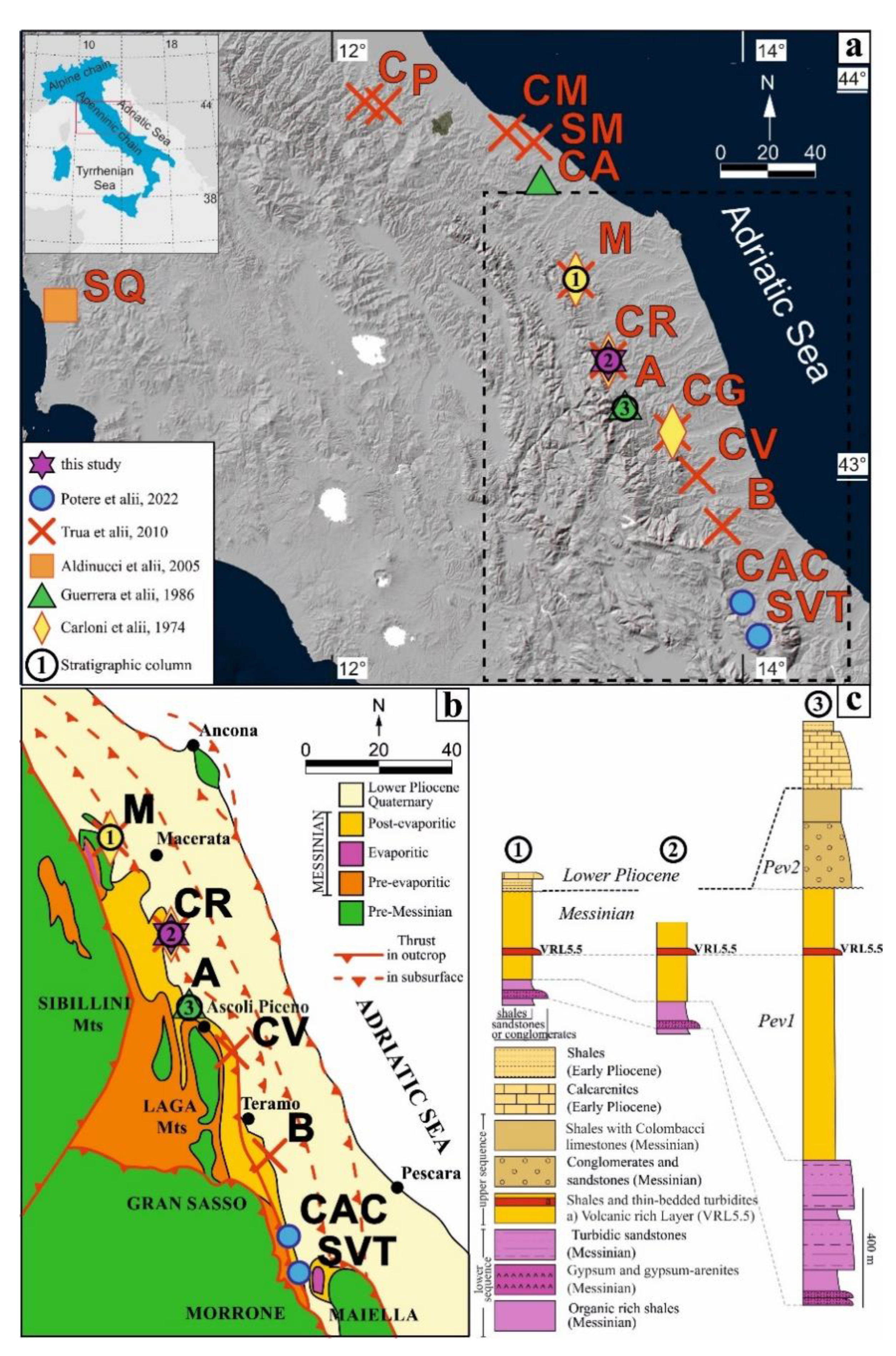
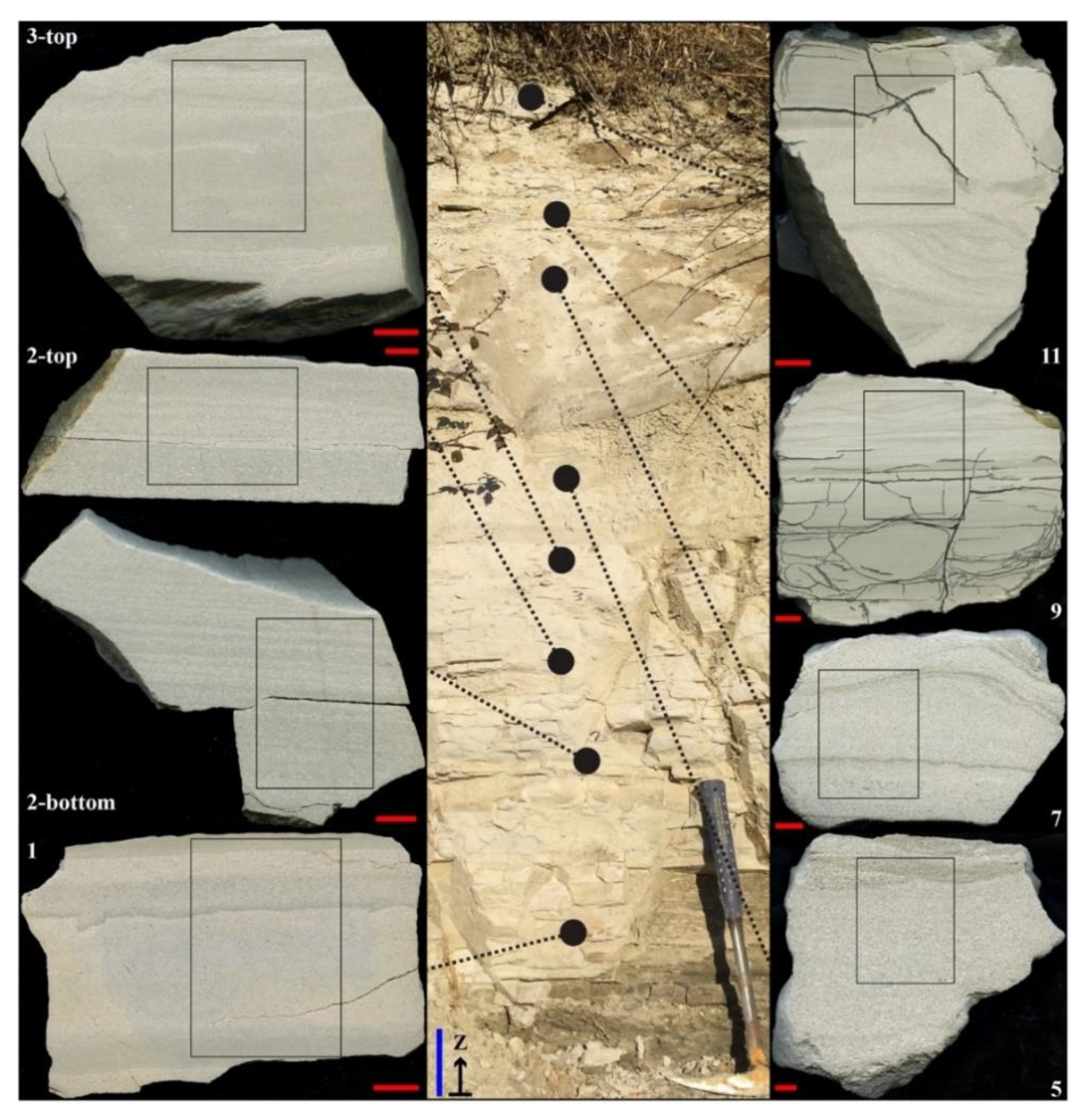

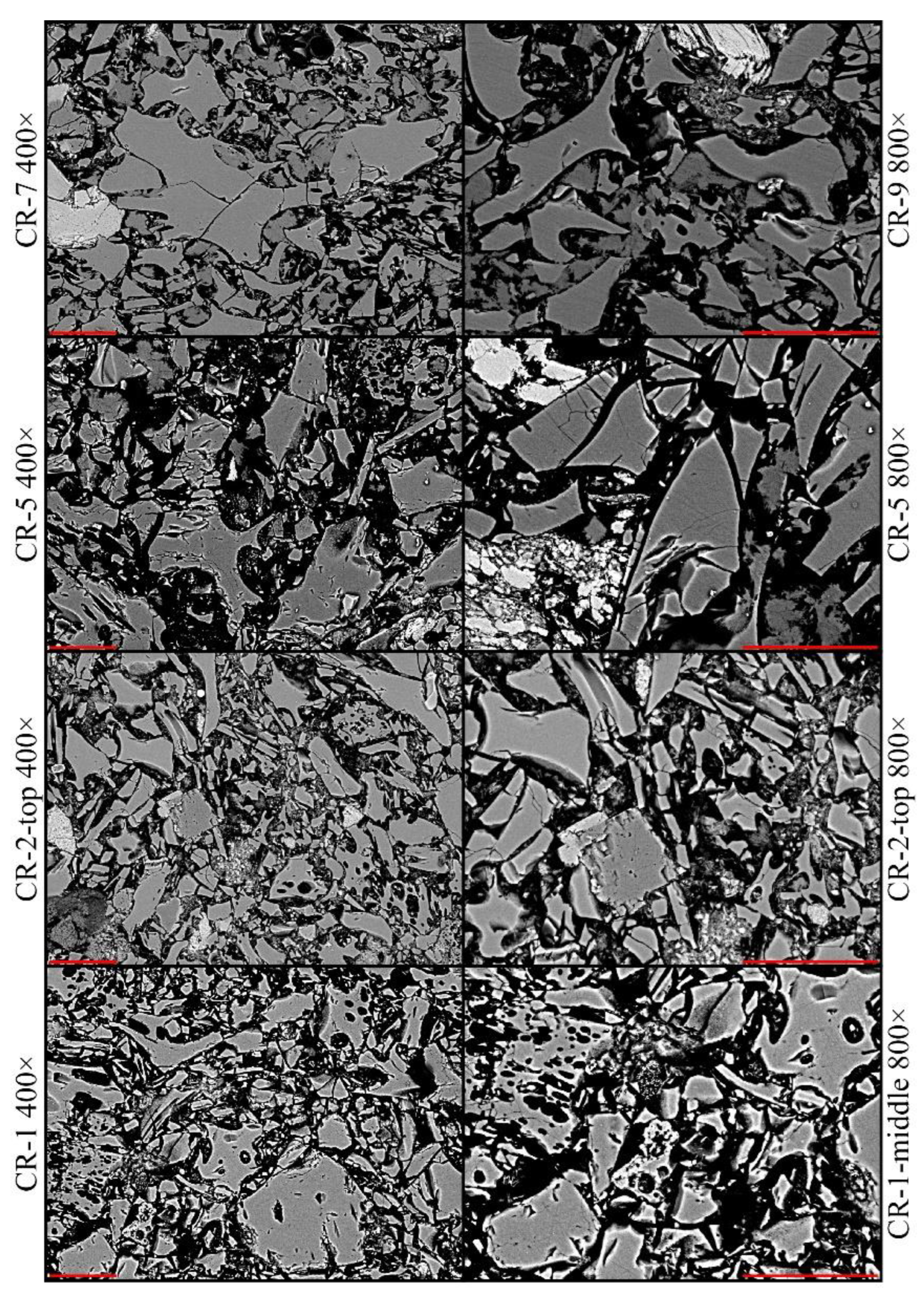
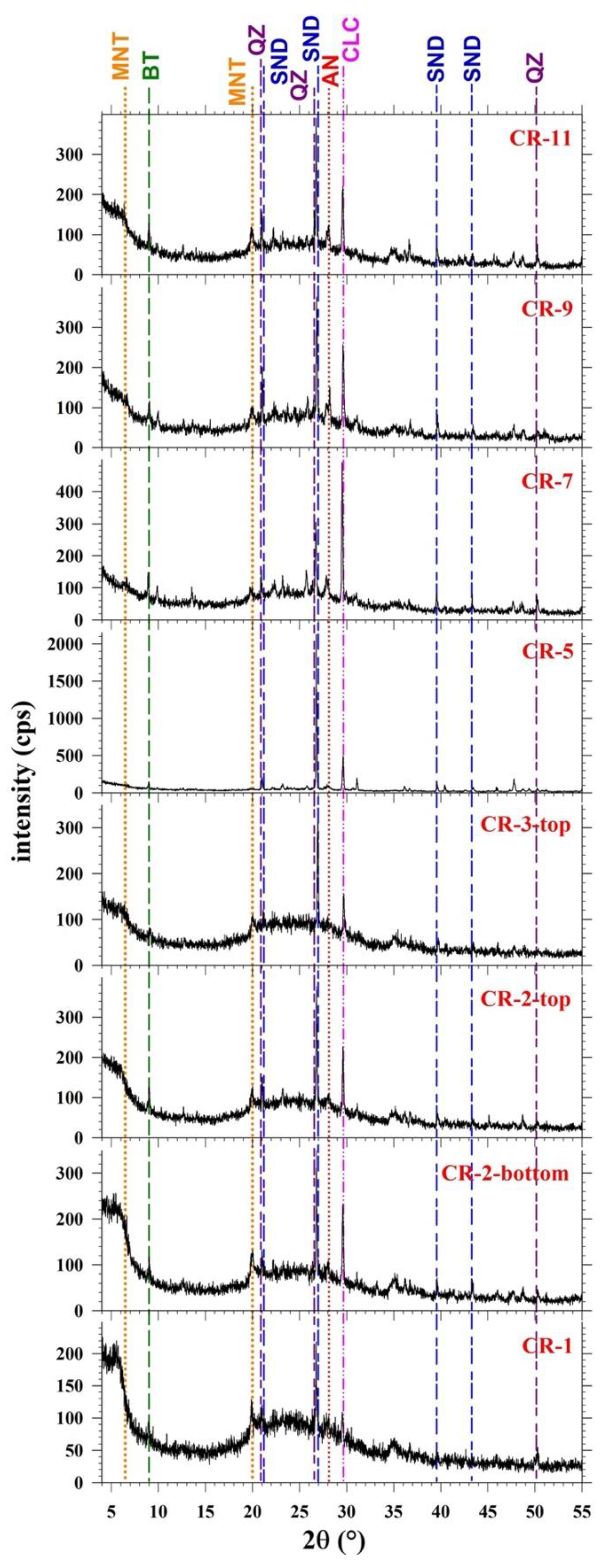
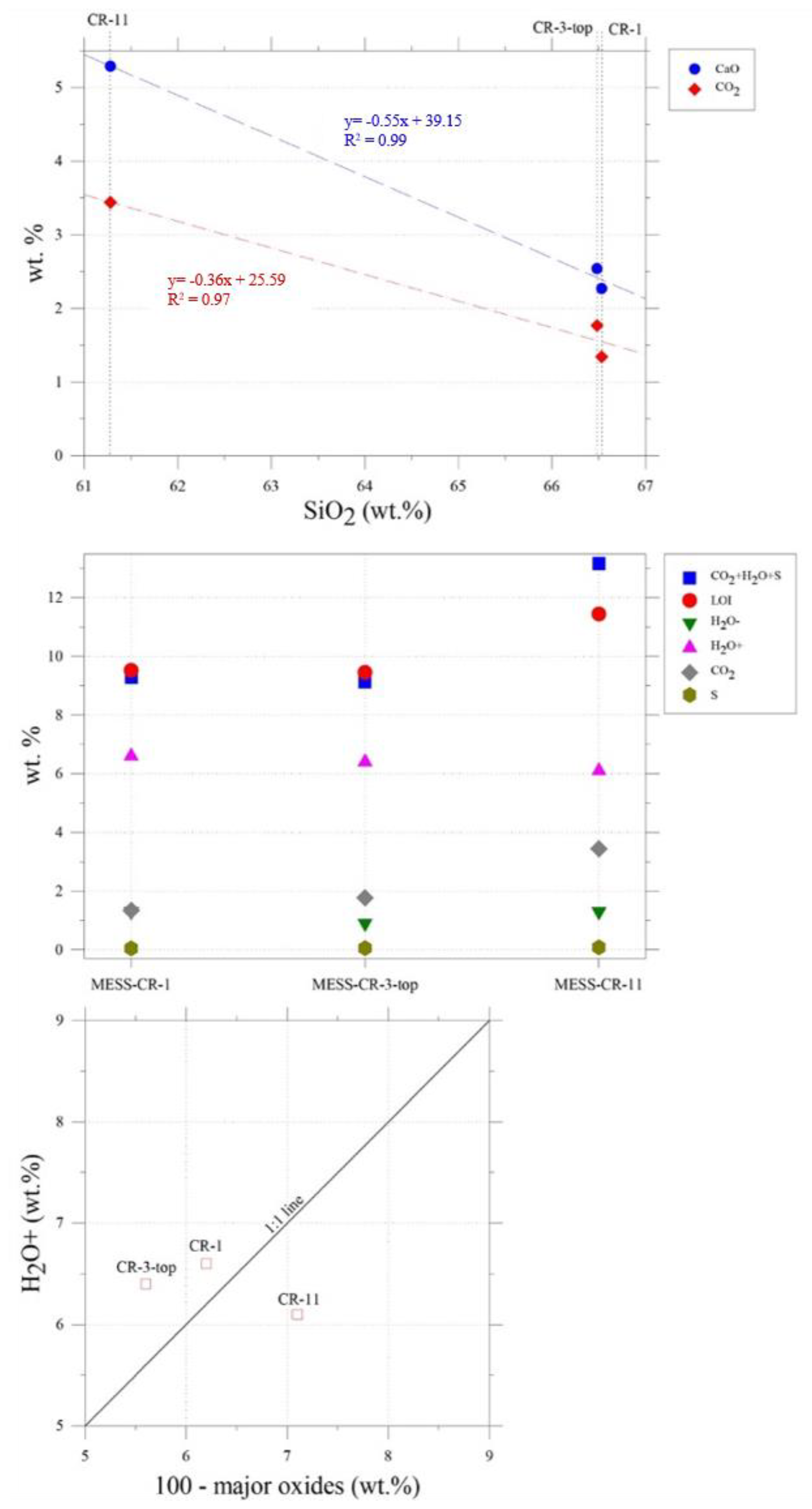
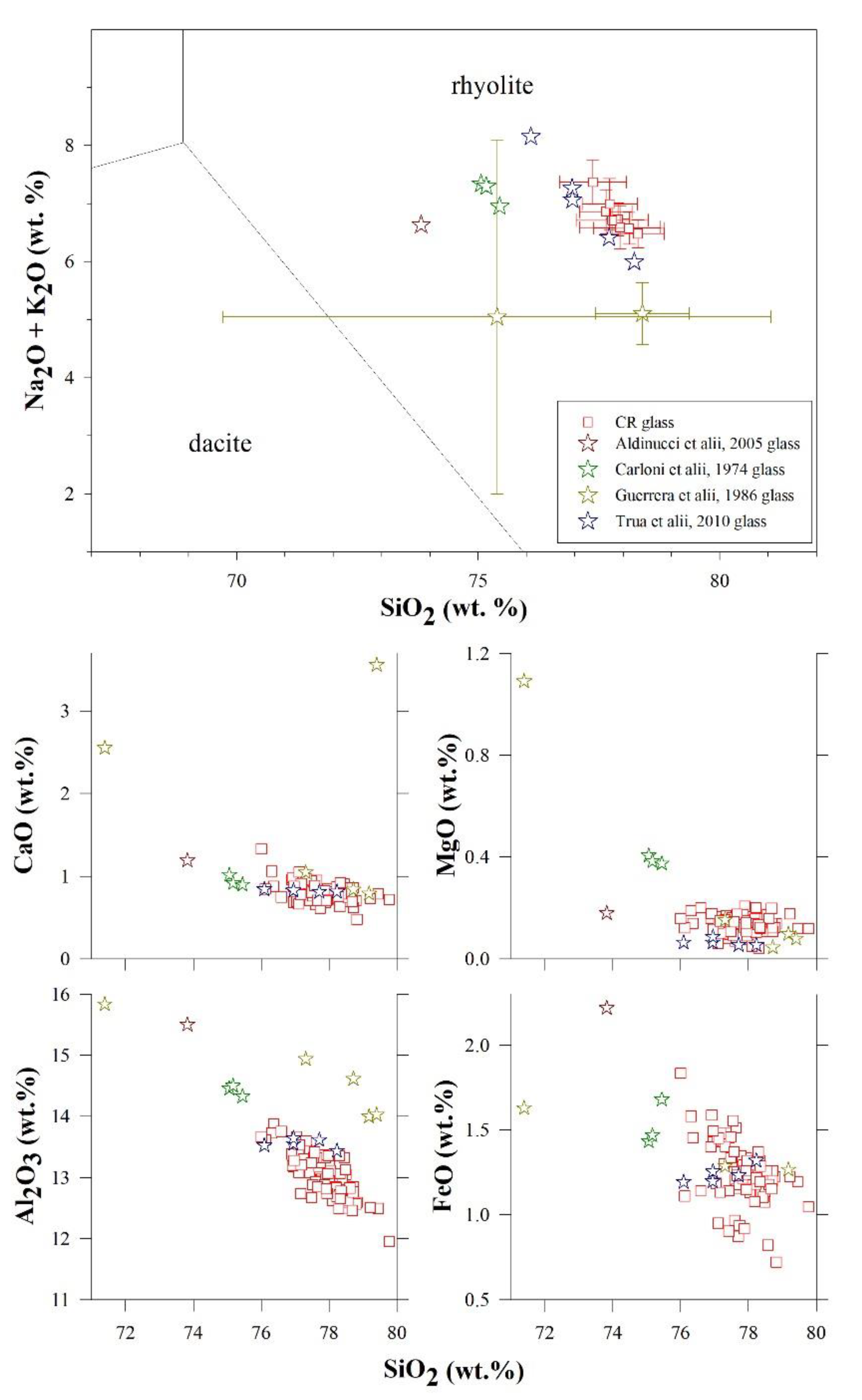


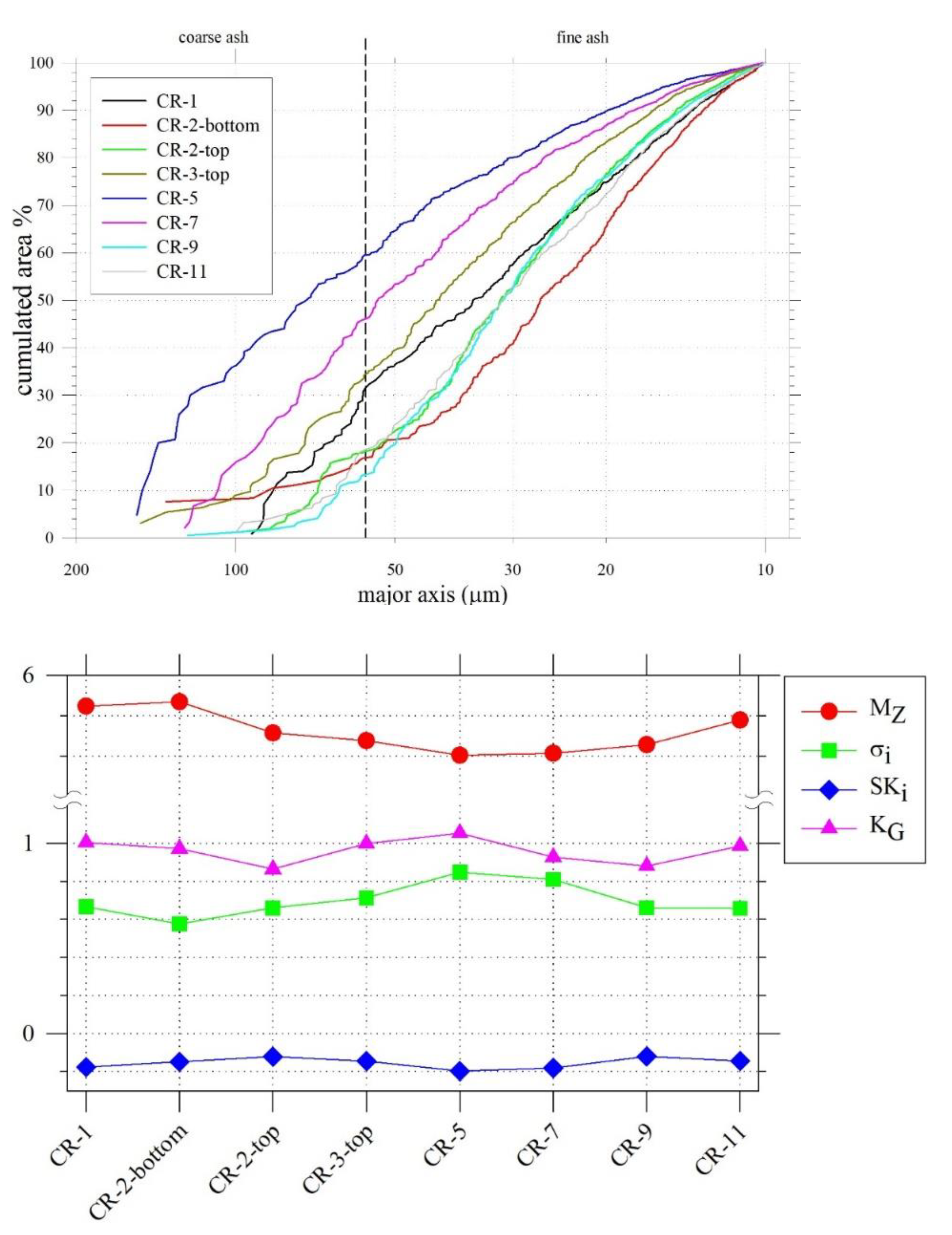

Publisher’s Note: MDPI stays neutral with regard to jurisdictional claims in published maps and institutional affiliations. |
© 2022 by the authors. Licensee MDPI, Basel, Switzerland. This article is an open access article distributed under the terms and conditions of the Creative Commons Attribution (CC BY) license (https://creativecommons.org/licenses/by/4.0/).
Share and Cite
Potere, D.; Scisciani, V.; Piochi, M.; Pierantoni, P.P.; Mormone, A.; Nazzari, M.; Scarlato, P.; Iezzi, G. The Volcanic-Rich Layer of the “Camporotondo (Marche, Italy)” Section: Petrography and Sedimentation of an Unknown Distal Messinian Eruption. Minerals 2022, 12, 893. https://doi.org/10.3390/min12070893
Potere D, Scisciani V, Piochi M, Pierantoni PP, Mormone A, Nazzari M, Scarlato P, Iezzi G. The Volcanic-Rich Layer of the “Camporotondo (Marche, Italy)” Section: Petrography and Sedimentation of an Unknown Distal Messinian Eruption. Minerals. 2022; 12(7):893. https://doi.org/10.3390/min12070893
Chicago/Turabian StylePotere, Davide, Vittorio Scisciani, Monica Piochi, Pietro Paolo Pierantoni, Angela Mormone, Manuela Nazzari, Piergiorgio Scarlato, and Gianluca Iezzi. 2022. "The Volcanic-Rich Layer of the “Camporotondo (Marche, Italy)” Section: Petrography and Sedimentation of an Unknown Distal Messinian Eruption" Minerals 12, no. 7: 893. https://doi.org/10.3390/min12070893
APA StylePotere, D., Scisciani, V., Piochi, M., Pierantoni, P. P., Mormone, A., Nazzari, M., Scarlato, P., & Iezzi, G. (2022). The Volcanic-Rich Layer of the “Camporotondo (Marche, Italy)” Section: Petrography and Sedimentation of an Unknown Distal Messinian Eruption. Minerals, 12(7), 893. https://doi.org/10.3390/min12070893






